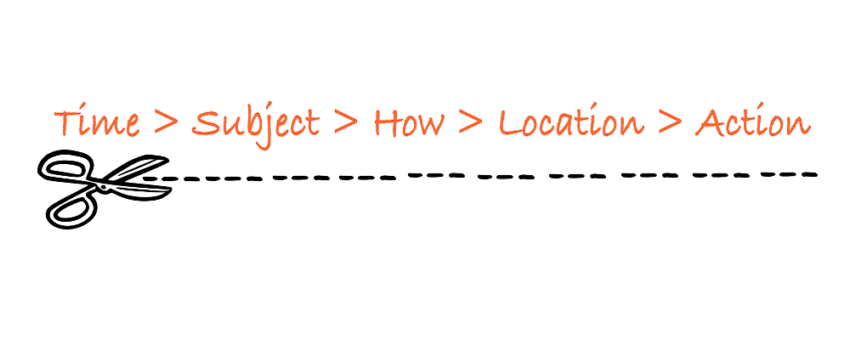What is the most common sentence order in Chinese?
📌 Time + Subject + How + Location + Action
* Time words can either go after the subject or before the subject.
* If you want to specify the direction, the directional word should come after ‘how’ and before ‘location’.
| Time | Subject | How | Direction | Location | Action |
| 去年 | 弟弟 | 坐船 | 来 | 台湾 | 看我 |
| Qùnián | dìdi | zuò chuán | lái | táiwān | kàn wǒ |
| Last year | (my) brother | took a boat | (to) come (to) | Taiwan | to see me |
昨天我搭火车去上海见朋友
Zuótiān wǒ dā huǒchē qù Shànghǎi jiàn péngyǒu
I took a train to Shanghai to meet friends yesterday.
早上妈妈开车去超市买东西
Zǎoshang māma kāichē qù chāoshì mǎi dōngxi
Mom drove to the supermarket to buy things this morning.
Two common sentence structures
📌 Subject – Verb – Object (SVO)
Like English, Chinese usually uses the form Subject-Verb-Object (SVO). The subject is the noun or pronoun that performs the action described by the verb. The verb is the action or state of being that the subject is performing or experiencing. The object is the noun or pronoun that receives the action of the verb.
For example, in the sentence “She eats an apple,” “She” is the subject, “eats” is the verb, and “an apple” is the object. The subject “She” is performing the action of eating, and the object “an apple” is what she is eating.
| Subject | Verb | Object | |
| Chinese | 她 tā | 吃 chī | 苹果 píngguǒ |
| English | She | eats | (an) apple |
| Chinese | 哥哥 gēge | 踢 tī | 球 qiú |
| English | Elder brother | kicks | the ball |
他做完工作了他做完工作了
He finished the work.
我見過那個人我见过那个人
I’ve met that guy.
📌 Topic – Comment
In this structure, the sentence starts with a “topic,” which is the main idea or subject that the speaker wants to discuss. The topic is often a noun phrase, and it is sometimes followed by a particle, such as “about,” “regarding,” “concerning,” or “with respect to,” that indicates that what follows is a comment on the topic.
The “comment” is the part of the sentence that provides more information about the topic, such as an opinion, a description, a fact, or an explanation. The comment may consist of one or more clauses, and it often contains the verb that describes the action or state related to the topic.
| Topic | Comment | |
| Chinese | 你做的咖啡 Nǐ zuò de kāfēi | 我很爱 wǒ hěn ài |
| English | The coffee you made | I love it so much |
| Chinese | 学中文 xué Zhōngwén | 不容易 bù róngyì |
| English | Learning Chinese | not easy |
工作他做完了工作他做完了
He finished the work.
那個人我見過那个人我见过
I’ve met that guy.
有關那本書的資料都放在圖書館有关那本书的资料都放在图书馆
The information about that book is all kept in the library.
📕 Why do we need Topic-comment structure?
Which one is better?
Since the Chinese sentence structure follows the S-V-O order, which is very similar to English, most people find it easier to learn, and that’s why it’s taught earlier in textbooks. However, the S-V-O structure can be lengthy, and it may not always be the most natural way to express oneself in conversational Chinese. In casual conversations, native speakers prefer to use the topic-comment structure for its simplicity and directness.
In the topic-comment structure, the object can often serve as the topic, which means that it’s easy to convert an S-V-O structured sentence to a topic-comment structure by moving the object to the beginning of the sentence.
The most important aspect of the topic-comment structure is that you can drop the subject when it’s clear from context. This is a common practice in casual conversations.
S-V-O
你吃飯了嗎?你吃饭了吗?
Have you eaten?
⬇️
Topic-Comment
飯你吃了嗎?饭你吃了吗?
Have you eaten?
⬇️
Drop the subject when it’s clear from context
飯吃了嗎?饭吃了吗?
Have you eaten?
The above three sentences are all correct and good, but if you ask me which one is better, my answer is:
| S-V-O | Formal, written |
| T-C | Casual, spoken |
| Drop Subject | Natural in casual conversation |
Can I always use S-V-O?
Yes, of course you can. However, it’s still essential to learn the T-C structure, so that you can understand what people are saying. It’s also important to note that dropping the subject in English turns the sentence into a command, but this is not the case in Chinese.
In fact, there is one situation where I strongly recommend using the T-C structure!
Greetings and Wishes
最近好嗎?最近好吗?
How have (you) been recently?
飯吃了嗎?饭吃了吗?
Have you eaten?
生日快樂!生日快乐!
Happy birthday!


